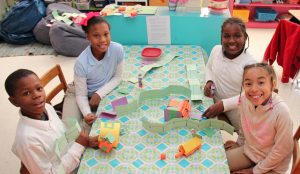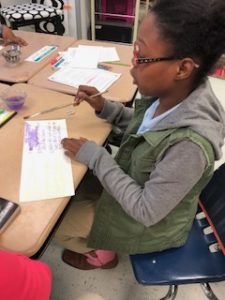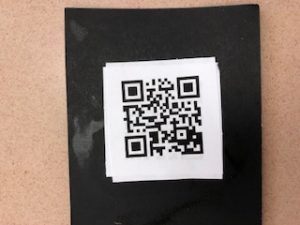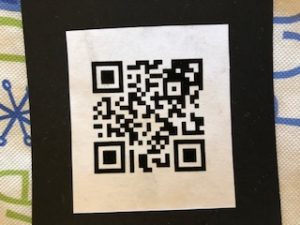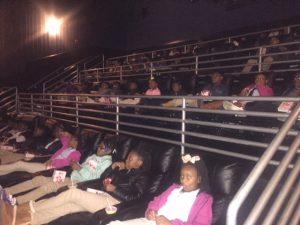This week, students have been learning about simple, series, and parallel electrical circuits. Teachers showed students the painting Broadway Boogie Woogie by Piet Mondrian. Students looked at the painting and identified the types of lines that Mondrian used (parallel, intersecting, perpendicular). We also identified different kinds of electrical circuits that can be found in the painting. Students then created a replication of Mondrian’s painting to either show a series or parallel circuit. Once the art was created, students had to identify the source, loads, connectors, and whether or not the circuit was open or closed.
Idiom Art
We have been shaking a leg since we have returned back at school from our snow days. We have so much to learn before we kick the bucket; ha, I’m not pulling your leg. We have been writing a lot of poetry, researching poets, and creating PowerPoints, but the icing on the cake was this idiom art that we made. We learned about space in art while showing the figurative meaning of idioms. So fun. So funny. So not literal. Thankfully, we aren’t couch potatoes, and since we are all in the same boat, we have to beat the gun and keep pushing on until May! Holy Cow, there isn’t much time left in 4th grade! There is NO time to feel under the weather! 

Fraction Friends
For the past week, we have been learning about equivalent fractions. In order to further understanding, we had students create equivalent fraction robots. Before creating the robots, we talked about how we could turn trash into treasure. Students looked at trash art by artists around the world. Once they had an idea of how to create their robots, students had a sheet that they had to multiply and divide in order to find equivalent fractions. The fractions represented each body part. Students had to go find the body part that matched the equivalent fraction they found in so that they could put together their robot.
Dancing the Charleston with Equivalent Fractions
The students learned about the Harlem Renaissance and that the Charleston is a famous dance craze from that era. Students studied the movements of the Charleston and used these moves to showcase their learning of equivalent fractions.
The students began with a fraction and had to find one equivalent fraction by multiplying and one by dividing. The students then correlated this to medium, high, and low levels of movement in dance.
- High Level – Equivalent Fraction Found by Multiplying (the numbers of the fraction are getting higher)
- Medium Level – Beginning Equivalent Fraction
- Low Level – Equivalent Fraction Found by Dividing (the numbers of the fraction are getting lower)
Come by our hall and see videos of the students showcasing their dances. Each class has a QR code linked to their video on a display in the hall.
Equivalent Fractions
And the Winner Is……
For the past three weeks, we have been reading President of the Whole Fifth Grade by Sherri Winston. We have also been studying the election process. To further our understanding of an election, we held our own class election. First, students were nominated by their classmates. Each class then held a primary and elected two students to serve in the fourth grade class president election. In the final election, students had to prepare and give a speech to their classmates.
Pictured below are the six students selected to run in the presidential election.
From left to right:
Kimora Garner, Sydney Ridgeway, Tommaj Harris, Ira Hamilton, Aja Stephens, and Zykeria Evans
AND THE WINNER IS..
ZYKERIA EVANS
Pictured below is Zykeria giving her speech.
Will the Real Abraham Lincoln Please Stand Up?
This past week, the students were able to experience an infusion lesson with the art teacher, Mr. Bryant, as a part of learning about our 16th president, Abraham Lincoln. The students began by acting out a play called, Will the Real Abraham Lincoln Please Stand Up. The play was about three characters who all claimed to be the real Abraham Lincoln. Each character gave a lot of true information about the life and presidency of Abraham Lincoln, but two of them also gave some false information. The students had to figure out which Abraham Lincoln was the real one. The students wrote down important facts about Lincoln’s life based on the information read in the play. Next, the students watched a video about Abraham Lincoln and wrote down more facts about his life. See pictures of us working here:
Mr. Bryant discussed how these facts came from two different sources: one a play (print source) and one a video (digital source). He discussed that these are like complementary colors in art: they are different, but they complement each other and work together to create beautiful artwork just like our facts work together to tell the story of Abraham Lincoln. The students then used their facts, complementary colors, and a screen-print design of Lincoln to create a very unique artwork of Abraham Lincoln. Each class had a slightly different silhouette of Lincoln to differentiate between the classes. See the pictures of our artwork here:
After creating the artwork, students recorded themselves stating one of the most interesting things they learned about Abraham Lincoln and created a short video collage of these statements. You can open your camera app on your phone and hover over each image below to see each class’s video:
Wonder
Winner, Winner, Chicken Dinner!!
Elise in Mrs. Watts’s class is headed to the regional reading fair after placing 1st place in her division at the school and district levels. She did her reading fair board on the Chronicles of Narnia book The Lion, the Witch, and the Wardrobe. We are very proud of Elise’s work, and we all wish her the best of luck at regionals!
Stylish Food on the Go!
Over the past few weeks, the students have been learning the process of the digestive system. Students studied the different styles of the famous artist, Van Gogh, Dali, and Picasso and then created the parts of the digestive system. Look carefully- Do you notice which style is whose? Can you find the liver, pancreas, large intestine or any other parts of the digestive system?











